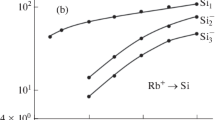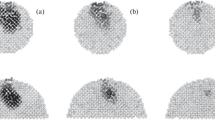Abstract—
The influence of the form of the Ar–Si interatomic potential on the results of simulating the physical sputtering of amorphous Si by low-energy Ar ions is analyzed. The yields of Si sputtering by Ar ions with an energy of 50–300 eV at normal incidence are calculated using the molecular dynamics (LAMMPS software) and the Monte Carlo methods by means of the MOTREV program developed at the Skobeltsyn Institute of Nuclear Physics, the Moscow State University, and used quantum-mechanical elastic-scattering cross sections. The semiempirical Molière and ZBL pair potentials and a potential developed on the basis of density functional theory calculations are applied to describe Ar–Si interaction. The energy dependences of the sputtering yields obtained using different potentials are analyzed in this paper. Conclusions concerning the applicability of the considered Ar—Si interaction potentials to simulation of the physical sputtering of amorphous Si in the indicated range of projectile energies are drawn.






Similar content being viewed by others
REFERENCES
P. Sigmund, Phys. Rev. 184 (2), 383 (1969). https://doi.org/10.1103/PhysRev.184.383
K. Wittmaack, Phys. Rev. 68 (23), 235211 (2003). https://doi.org/10.1103/PhysRevB.68.235211
P. C. Zalm, J. Appl. Phys. 54 (5), 2660 (1983). https://doi.org/10.1063/1.332340
D. V. Lopaev, T. V. Rakhimova, A. T. Rakhimov, A. I. Zotovich, et al., J. Phys. D: Appl. Phys. 51 (2), 02LT02 (2017). https://doi.org/10.1088/1361-6463/aa9c18
P. Sigmund, Sputtering by ion bombardment: Theoretical concepts, in Sputtering by Particle Bombardment II.Topics in Applied Physics, Vol. 52, Ed. by R. Behrisch (Springer, Berlin, 1981).
R. Behrisch, Sputtering by Particle Bombardment: Experiments and Computer Calculations from Threshold to MeV Energies, in Sputtering by Particle Bombardment.Topics in Applied Physics, Vol. 110, Ed. by R. Behrisch and W. Eckstein (Springer, Berlin–Heidelberg, 2007).
S. Saito, A. M. Ito, A. Takayama, T. H. Kenmotsu, et al., J. Nucl. Mater. 415 (1), S208 (2011). https://doi.org/10.1016/j.jnucmat.201012.233
A. P. Palov, G. G. Balint-Kurti, E. N. Voronina, and T. V. Rakhimova, J. Vac. Sci. Technol. A 36, 041303 (2018). https://doi.org/10.1116/1.5027387
R. A. Stansfield, K. Broomfield, and D. C. Clary, Phys. Rev. 39, 7680 (1989).
G. Molière, Z. Naturforsch. A2, 133 (1947).
J. P. Biersack and J. F. Ziegler, Nucl. Instrum. Methods Phys. Res. 194, 93 (1982).
K. Wittmaack, J. Appl. Phys. 96 (5), 2632 (2004). https://doi.org/10.1063/1.1776318
V. I. Shulga, Appl. Surf. Sci. 439, 456 (2018). https://doi.org/10.1016/j.apsusc.2018.01.039
R. Smith, Atomic and Ion Collisions in Solids and at Surfaces: Theory, Simulation and Applications (Cambridge University Press, New York, 2005).
M. Z. Hossain, J. B. Freund, and H. T. Johnson, Nucl. Instrum. Methods Phys. Res., Sect. B 257 (7), 1061 (2009). https://doi.org/10.1016/j.nimb.2009.01.137
F. H. Stillinger and T. A. Weber, Phys. Rev. B: Condens. Matter Mater. Phys. 31 (8), 5262 (1985). https://doi.org/10.1103/PhysRevB.31.5262
V. I. Shulga, Nucl. Instr. Methods. Phys. Res., Sect. B 254 (2), 200 (2007). .https://doi.org/10.1016/j.nimb.2006.11.068
M. Timonova, B.-J. Lee, and B. J. Thijsse, Nucl. Instrum. Methods Phys. Res., Sect. B 225 (1), 195 (2007). https://doi.org/10.1016/j.nimb.2006.11.023
D. Humbird and D. B. Graves, Pure Appl. Chem. 74 (3), 419 (2002). https://doi.org/10.1351/pac200274030419
A. A. Sycheva, E. N. Voronina, and T. V. Rakhimova, J. Surf. Invest.: X-Ray, Synchrotron Neutron Tech., 12 (6), 1270 (2018).
S. Plimpton, J. Comput. Phys. 117, 1 (1995). https://doi.org/10.1006/jcph.1995.1039
V. Sadovnichy, A. Tikhonravov, Vl. Voevodin, and Vl. Opanasenko, in Contemporary High Performance Computing: From Petascale to Exacsale, Ed. by J. S. Vetter (Chapman & Hall/CRC Computational Science, Boca Raton, USA, 2013), p. 283.
A. Stukovski, Modell. Simul. Mater. Sci. Eng. 18 (1), 015012 (2010). https://doi.org/10.1088/0965-0393/18/1/015012
D. J. Oostra, A. Haring, R. P. van Ingen, and A. E. de Vries, J. Appl. Phys. 64 (1), 315 (1988). https://doi.org/10.1063/1.341429
M. Balooch, M. Moalem, W. -E. Wang, and A. V. Hamza, J. Vac. Sci. Technol. A 14 (1), 229 (1996). https://doi.org/10.1116/1.579924
N. A. Kubota, D. J. Economou, and S. J. Plimpton, J. Appl. Phys. 83 (8), 4055 (1998). https://doi.org/10.1063/1.367225
J. E. Rubio, L. A. Marques, M. Jaraíz, et al., Nucl. Instr. Methods. Phys. Res., Sect. B 102, 301 (1995). https://doi.org/10.1016/0168-583X(95)80157-H
Funding
This work was supported by the Russian Science Foundation grant no. 14-12-01012 and used equipment of the shared research facilities of HPC computing resources at Lomonosov.
Author information
Authors and Affiliations
Corresponding author
Additional information
Translated by L. Kulman
Rights and permissions
About this article
Cite this article
Sycheva, A.A., Voronina, E.N. & Palov, A.P. Analysis of the Results of Silicon Sputtering Simulation as Functions of Different Ar–Si Potentials. J. Surf. Investig. 13, 1272–1279 (2019). https://doi.org/10.1134/S1027451019060521
Received:
Revised:
Accepted:
Published:
Issue Date:
DOI: https://doi.org/10.1134/S1027451019060521




